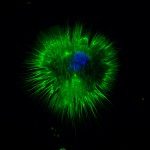Lien vers Pubmed [PMID] – 17804598
Development 2007 Oct;134(20):3723-32
Latent TGF-beta binding protein 1 (LTBP1) is a member of the LTBP/fibrillin family of extracellular proteins. Due to the usage of different promoters, LTBP1 exists in two major forms, long (L) and short (S), each expressed in a temporally and spatially unique fashion. Both LTBP1 molecules covalently interact with latent TGF-beta and regulate its function, presumably via interaction with the extracellular matrix (ECM). To explore the in vivo role of Ltbp1 in mouse development, at the time when only the L isoform is expressed, we mutated the Ltbp1L locus by gene targeting. Ltbp1L-null animals die shortly after birth from defects in heart development, consisting of the improper septation of the cardiac outflow tract (OFT) and remodeling of the associated vessels. These cardiac anomalies present as persistent truncus arteriosus (PTA) and interrupted aortic arch (IAA), which are associated with the faulty function of cardiac neural crest cells (CNCCs). The lack of Ltbp1L in the ECM of the septating OFT and associated vessels results in altered gene expression and function of CNCCs and decreased Tgf-beta activity in the OFT. This phenotype reveals a crucial role for Ltbp1L and matrix as extracellular regulators of Tgf-beta activity in heart organogenesis.

